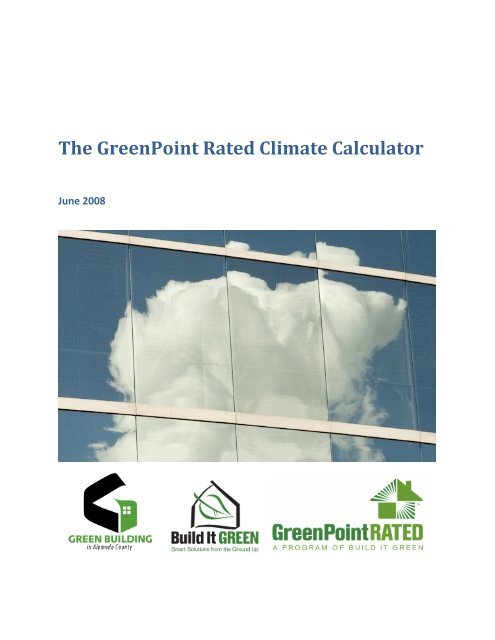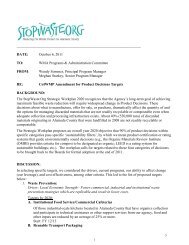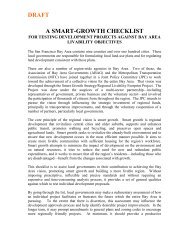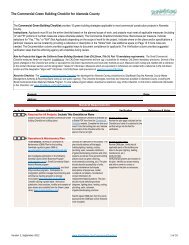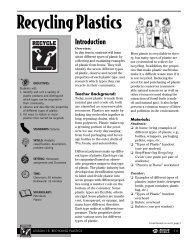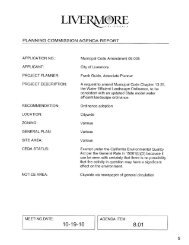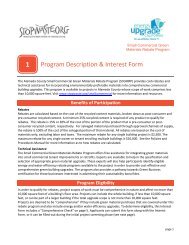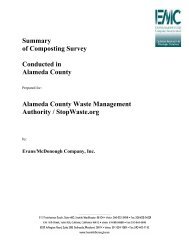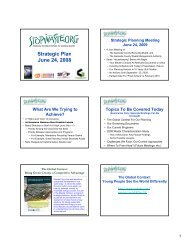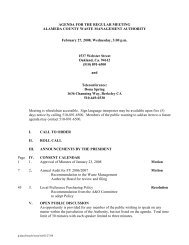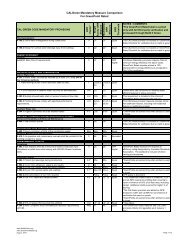The GreenPoint Rated Climate Calculator - StopWaste.Org
The GreenPoint Rated Climate Calculator - StopWaste.Org
The GreenPoint Rated Climate Calculator - StopWaste.Org
Create successful ePaper yourself
Turn your PDF publications into a flip-book with our unique Google optimized e-Paper software.
<strong>The</strong> <strong>GreenPoint</strong> <strong>Rated</strong> <strong>Climate</strong> <strong>Calculator</strong>June 2008
<strong>GreenPoint</strong> <strong>Rated</strong> <strong>Climate</strong> <strong>Calculator</strong> 2ContentsExecutive Summary......................................................................................................................... 3Introducing the <strong>GreenPoint</strong> <strong>Rated</strong> <strong>Climate</strong> <strong>Calculator</strong>................................................................... 4Background & methodology ........................................................................................................... 5Notable findings.............................................................................................................................. 6What these findings mean for….................................................................................................... 11Policymakers & climate action planners...........................................................................................11Builders, developers & building designers........................................................................................11Next steps ..................................................................................................................................... 11Case studies .................................................................................................................................. 13Project background....................................................................................................................... 19Appendices.................................................................................................................................... 21A. Methodology..................................................................................................................... 22B. Measures Included in the <strong>Calculator</strong> ................................................................................ 24C. Emissions Factors & Coefficients ...................................................................................... 29D. Measures Not Yet Included in the <strong>Calculator</strong>................................................................... 30E. Measures Not Applicable to the <strong>Calculator</strong>...................................................................... 34F. Other Emissions <strong>Calculator</strong>s ............................................................................................. 36
<strong>GreenPoint</strong> <strong>Rated</strong> <strong>Climate</strong> <strong>Calculator</strong> 3Executive SummaryA number of lifestyle-based carbon calculators have been developed to estimate an individual’s orhousehold’s carbon footprint, but until now, no tool existed to measure the total avoided greenhousegas emissions from building green homes. 1<strong>The</strong> new <strong>GreenPoint</strong> <strong>Rated</strong> <strong>Climate</strong> <strong>Calculator</strong>, developed by a team led by Green Building in AlamedaCounty, provides this information in a way that’s systematic, credible and backed by third-partyverification.<strong>The</strong> <strong>Climate</strong> <strong>Calculator</strong> is likely to be an influential tool for helping California’s residential buildingindustry reduce its carbon footprint. <strong>The</strong> <strong>Calculator</strong> is an adjunct to the <strong>GreenPoint</strong> <strong>Rated</strong> program,which provides a consumer label for green homes.When a house or multifamily building undergoes the <strong>GreenPoint</strong> Rating process, the Rater will use the<strong>Climate</strong> <strong>Calculator</strong> to generate data on greenhouse gas (GHG) emissions avoided, measured in carbondioxide equivalents, or CO 2 e. Other savings are also calculated, including non-CO 2 savings like gallons ofwater, tons of waste, kilowatt-hours of electricity, and therms of natural gas.Notable findings Buildings in denser, transit-oriented communities provide the greatest emissions reductions. In the building’s design, the most important CO 2 e reduction strategies are building energyefficiency, reduced home size, photovoltaic systems, energy-efficient appliances (including non-HCFC refrigerants), and water-efficient landscapes and fixtures. Construction and demolition waste recycling produces significant CO 2 e savings for the buildingand community. Green remodeling reduces net CO 2 e emissions, while constructing new housing (whether green orconventional) increases net CO 2 e emissions. Given that 70% of homes in the state were builtbefore 1980, 2 the opportunity for true emissions reduction is enormous in the home remodelingsector.1 See Appendix F for an abbreviated list of carbon calculators.2 California Energy Commission household forecast for California Energy Demand 2008–2018, November 2007,report number CEC-200-2007-015-SF2.
<strong>GreenPoint</strong> <strong>Rated</strong> <strong>Climate</strong> <strong>Calculator</strong> 4Introducing the <strong>GreenPoint</strong> <strong>Rated</strong> <strong>Climate</strong> <strong>Calculator</strong>Green buildings incorporate a suite of environmentally preferable practices during siting, design andconstruction. Consequently, most green buildings are thought to have lower carbon footprints thantraditionally built or remodeled buildings. But how much lower? Which green building strategies aremost effective for reducing greenhouse gas (GHG) emissions? While the energy-related emissionssavings from the building industry are well understood, how do the non-energy benefits of greenbuildings compare? How will the growing inventory of green homes contribute to the state’s ambitiousGHG reduction goals?<strong>The</strong> <strong>GreenPoint</strong> <strong>Rated</strong> <strong>Climate</strong> <strong>Calculator</strong> helps answer these questions. When a remodeled or newlybuilt residence undergoes the <strong>GreenPoint</strong> Rating process, a third-party Rater will use the <strong>Calculator</strong> togenerate data on GHG emissions avoided and other savings. 3 <strong>The</strong> <strong>Climate</strong> <strong>Calculator</strong> produces four setsof data: CO 2 e data derived from the building’s green design features, including:o building energy efficiency,o reduced home size,o photovoltaic systems,o energy-efficient appliances,o advanced refrigerants,o water-efficient plumbing fixtures, ando water-efficient landscapes; CO 2 e data related to the recycling of construction and demolition waste; CO 2 e data related to the project’s location, which quantifies the potential reduction in miles drivenby residents who live in more compact, transit-oriented, mixed-use developments; and Non-CO 2 savings, including gallons of water, tons of waste, kilowatt-hours of electricity, and thermsof natural gas.All these results will be incorporated into a new <strong>GreenPoint</strong> <strong>Rated</strong> consumer label (see page 12 for apreview illustration).3 See the Build It Green website at www.builditgreen.org for more information on the <strong>GreenPoint</strong> <strong>Rated</strong> programand the Green Building Guidelines for New Homes, Multifamily buildings, and Existing Homes.
<strong>GreenPoint</strong> <strong>Rated</strong> <strong>Climate</strong> <strong>Calculator</strong> 5Background & methodology<strong>The</strong> green building measures included in the <strong>Calculator</strong> aredrawn from the Green Building Guidelines published byBuild It Green, which includes single-family newconstruction, multifamily new construction and singlefamilyexisting homes.<strong>The</strong> project team encountered some challenges as theysought to develop a <strong>Calculator</strong> based on accurate, verifiabledata and assumptions. Foremost was the need to make the<strong>Calculator</strong> truly representative of the numerous co-benefitsthat green buildings provide, some of which have impactson GHGs while others do not. Also, to be credible the<strong>Calculator</strong> had to reference valid standards, researchreports, and assumptions.Lastly, and perhaps most challenging, the <strong>Calculator</strong> mustwork for the <strong>GreenPoint</strong> Raters in the field. A calculator thatis too onerous to fill out would drive up the cost of<strong>GreenPoint</strong> Ratings, while an overly simplified calculatorwould lack credibility. <strong>The</strong> <strong>GreenPoint</strong> <strong>Rated</strong> <strong>Calculator</strong>currently meets these objectives, and will continue to berefined as more and better data becomes available and as<strong>GreenPoint</strong> Raters provide feedback based on theirexperience with using the <strong>Climate</strong> <strong>Calculator</strong> in the field.Energy Efficiency Strategies forExceeding Title 24Exceeding California’s Building EnergyEfficiency Standards (Title 24) results inreduced greenhouse gas emissions, lowerutility costs and increased comfort. Althoughappropriate strategies will differ depending onthe local climate, in general the top strategiesinclude:o Passive solar design with high thermalmasso Increased building insulationo High performance windowso 14+ SEER air conditionerso 92%+ AFUE furnaceso Pipe insulation on all hot water lineso Home Energy Rating System (HERS)inspections on quality of insulationinstallation, infiltration leakage and ductefficiencyFor information on these and other energyefficiency strategies, refer to the GreenBuilding Guidelines for Multifamily, NewHomes and Home Remodeling atwww.builditgreen.org.For a more detailed discussion of the <strong>Calculator</strong>’s methodology, see Appendix A. Appendix B lists all themeasures included in the <strong>Calculator</strong> at this time. Many Green Building Guidelines measures wereexcluded from the <strong>Calculator</strong> or deferred to a future version because of the measure’s low correlationwith climate change or resource benefits (such as light pollution reduction), insufficient data (forexample, no third-party study on the energy savings of a gearless elevator compared to a hydraulicelevator), or difficulty devising a way of measuring its impact (for example, environmentally preferablematerials). See Appendix D for a list of measures not yet included in the <strong>Calculator</strong> and Appendix E for alist of measures excluded from the <strong>Calculator</strong>.
<strong>GreenPoint</strong> <strong>Rated</strong> <strong>Climate</strong> <strong>Calculator</strong> 6Notable findings<strong>The</strong> findings described here are derived from the project team’s extensive research and analysis into thecorrelations between specific green building strategies and their impacts on GHG emissions andconsumption of energy, water and other resources. Othersconsulted on the <strong>Climate</strong> <strong>Calculator</strong> include:o climate change experts,o State of California agency staff, ando energy and green building leaders. 4 Buildings in denser, transit-oriented communitiesprovide the greatest emissions reductions. <strong>The</strong>research and analysis underpinning the development ofthe <strong>Climate</strong> <strong>Calculator</strong> confirmed what many land useexperts have long claimed: that a project’s location andlayout plays a larger role in its climate change impactsthan does the building’s design. On average, peopleliving in less sprawling, more transit-orientedcommunities and cities travel by car much less thanpeople living in lower density communities withoutgood access to public transit or local jobs.To assign GHG impacts related to a building’s location,the <strong>Climate</strong> <strong>Calculator</strong> uses average vehicle milestraveled (VMT) data based not just on a project’sdensity, but also on its proximity to public transit,shopping and other services, and on the neighborhood’saccessibility for pedestrians and bicyclists.Indoor Environmental QualityAlthough the <strong>Climate</strong> <strong>Calculator</strong> doesn’tspecifically address healthy home issues,better indoor environmental quality is one ofthe most important benefits of building green.Having a healthier home is also one of themain motivations for people to buy greenhomes, green products and green remodelingservices. Best practices for better indoorenvironmental quality include:o Noise and vibration control, especially inmultifamily and mixed-use buildingso Kitchen and bathroom fans that exhaustto the outsideo Track-off systems at entryways to keepdirt and other contaminants from enteringthe buildingo Low- or no-VOC paints, coatings andadhesiveso Pressed-wood products with reducedformaldehyde and flooring with low VOCemissionsFor information on these and other greenbuilding practices, see the Green BuildingGuidelines for Multifamily, New Homes andHome Remodeling at www.builditgreen.org.4 <strong>The</strong> project team and stakeholders are listed on page 19.
<strong>GreenPoint</strong> <strong>Rated</strong> <strong>Climate</strong> <strong>Calculator</strong> 7 In the building’s design, the most important CO 2 ereduction strategies are building energy efficiency,reduced home size, photovoltaic systems, energyefficientappliances, advanced refrigerants, and waterefficientlandscapes and fixtures.o Building energy efficiency. <strong>The</strong> <strong>GreenPoint</strong> <strong>Rated</strong><strong>Climate</strong> <strong>Calculator</strong>’s baseline assumptions includeall the building design strategies required to meetTitle 24 Energy Efficiency Standards. <strong>The</strong> <strong>Climate</strong><strong>Calculator</strong> uses the project’s Title 24 energymodeling results to assign a CO 2 e reduction valuebased on avoided emissions from energy savingsachieved by exceeding Title 24. This means that the<strong>Climate</strong> <strong>Calculator</strong> provides an aggregated CO 2 etotal for most of the building energy efficiencystrategies rather than presenting CO 2 e results forindividual strategies. Energy measures that arerequired in the California Building Energy Code (Title24) are not included in the energy savings analysisResource Conservation<strong>The</strong> <strong>GreenPoint</strong> <strong>Rated</strong> <strong>Climate</strong> <strong>Calculator</strong>calculates CO 2 e savings from construction anddemolition (C&D) waste reduction, which canbe significant. However, green buildingprovides many other resource conservationbenefits that aren’t reflected in the <strong>Climate</strong><strong>Calculator</strong>, such as:o Durable products that require lessfrequent maintenance and replacemento Advanced framing techniques, engineeredlumber, and Forest Stewardship Council(FSC)-certified framing lumbero Recycled-content building products, suchas decking, ceramic tiles and carpetso Flooring made from rapidly renewableresources such as cork, linoleum andbambooFor information on these and other greenbuilding strategies, refer to the Green BuildingGuidelines for Multifamily, New Homes andHome Remodeling at www.builditgreen.org.since they do not exceed minimum code requirements. For those energy-related measuresabove code minimums but not accounted for in Title 24 analysis, the <strong>Climate</strong> <strong>Calculator</strong> hasseparately quantified the energy and GHG savings. At this time, the Title 24 energy savings arebased on calculated kilowatt-hour per year reductions and are thus independent on the time ofday energy is conserved. Analysis for existing homes was calculated based on the improvedperformance over a typical home of the same vintage (see Appendix B for more information onmeasures included in the calculations for existing homes).o Home size efficiency. <strong>The</strong> size of a house or multifamily housing unit has a large impact on theamount of materials used to construct the home and its energy use once occupied. Largerhomes tend to use more heating and cooling energy and produce more construction waste. <strong>The</strong><strong>Climate</strong> <strong>Calculator</strong> factors in a home’s size to show the net energy benefits and reduced wasteof building compact spaces.o Photovoltaic systems. If a project has a solar electric system, the <strong>Climate</strong> <strong>Calculator</strong> uses thesystem’s estimated kilowatt-hour per year output to assign a CO 2 e reduction benefit. <strong>The</strong>emissions resulting from the project’s net electricity use are calculated using the unique powergeneration mix of the utility that serves that particular location. Solar hot water systems areaccounted for in Title 24, so are not broken out separately by the <strong>Climate</strong> <strong>Calculator</strong>.o Appliances. Energy- and water-efficient appliances are not accounted for in Title 24 but canrepresent a significant portion of a project’s CO 2 e savings.
<strong>GreenPoint</strong> <strong>Rated</strong> <strong>Climate</strong> <strong>Calculator</strong> 8o Central laundry. For multifamily projects, the largestappliance-related savings come from having centrallaundry facilities. When residents use commonlaundry facilities they tend to wash and dry largerloads less frequently than when laundry appliancesare located inside each individual home.o Advanced refrigerants. Using HCFC (R-22) and aleakage rate of 2% per year as the baselinecondition, the <strong>Calculator</strong> estimates the avoidedglobal warming potential (GWP) of using advancedrefrigerants, including HFC-134A and HFC-407A, inrefrigerators and air conditioners.o Water-efficient plumbing fixtures. <strong>The</strong> <strong>Calculator</strong>includes CO 2 e reductions for the efficient use ofwater indoors. Low-flow showerheads, faucets andtoilets provide significant water savings in homes.Depending on where the project is located andwhere the water supply is coming from, the waterimpacts on GHGs may be quite small compared tothe <strong>Calculator</strong>’s other savings areas. However, waterefficiency has other benefits, including helpingconserve the state’s diminishing supplies of potablewater.o Water-efficient landscapes. <strong>The</strong> <strong>Calculator</strong> includeswater savings from well designed and maintainedlandscapes that utilize a range of water-efficientelements. Principles taken from the Bay-FriendlyLandscaping Guidelines are included in <strong>GreenPoint</strong><strong>Rated</strong> as a basis for holistic water conservationtechniques outdoors. 5 Landscape waterconservation starts with creating drought-resistantsoils with compost and mulch, selecting low-waterWater ConservationWater conservation directly impacts energyuse at the state level, since energy is neededto source, purify, convey and heat water inhomes. Once used, even more energy is spentto move and then treat wastewater.Altogether, the management of water inCalifornia accounts for 19% of the state’selectricity and 30% of its natural gas usage.*And water efficiency has benefits beyond justenergy, including helping conserve the state’sdiminishing supplies of potable water.Measures that slow the flow of stormwaterrunoff, such as permeable paving, swales andgreen roofs, aren’t included in the <strong>GreenPoint</strong><strong>Rated</strong> <strong>Climate</strong> <strong>Calculator</strong> because their CO 2benefits are at present difficult to quantify forindividual projects. However, these measuresmay in fact have significant climate changebenefits. A report by the California EnergyCommission notes that increased runoff in theChino Basin results in more than 40,000 acrefeetper year of stormwater going intostormwater treatment facilities instead ofrecharging groundwater. <strong>The</strong> loststormwater’s energy value was 2,250 kWh peracre-foot on average, according to thereport.***“California’s Water-Energy Relationship,”California Energy Commission, Nov. 2005, document#CEC-700-2005-011-SF.**“<strong>The</strong> Role of Land Use in Meeting California’sEnergy and <strong>Climate</strong> Change Goals,” California EnergyCommission, Aug. 2007, document #CEC-600-2007-008-SF.using plants, planning for hydrozoned irrigation areas, and installing high efficiency irrigationtechnologies. <strong>The</strong>se strategies combined together can save large amounts of water.5 Information about the Bay-Friendly Landscaping program can be found at www.bayfriendly.org. For more detailson the landscaping guidelines used in the <strong>Calculator</strong>, see Appendix B.
<strong>GreenPoint</strong> <strong>Rated</strong> <strong>Climate</strong> <strong>Calculator</strong> 9 Construction and demolition waste recycling produces significant CO 2 e savings for the buildingand community. Construction and demolition (C&D) waste generation on an individual projectoccurs only at the time of construction and is not ongoing like energy use. However, recycling highlevels of C&D waste can avoid significant CO 2 e emissions for the first year on some projects as wellas provide ongoing community benefits by reducing emissions from landfills. 6Waste diversion is a critical consideration given the state’s approaching 2020 deadline for reducingGHG emissions. 7 Compared to measures such as energy efficiency that accrue emissions reductionsover time, C&D waste recycling provides immediate savings. Further, cities and local governmentsshould consider waste an ongoing source of GHG reductions because construction—and the waste itproduces—is an ongoing activity. California will add 2.6 million new homes by 2020, 8 and thus theimpacts from avoided construction waste are immense. At 5.6 tons of CO 2 e saved per home, 9recycling construction waste has the potential to reduce CO 2 e emissions by more than 14.5 milliontons by 2020! Green remodeling reduces net CO 2 e emissions, while constructing new homes (whether green orconventional) increases net CO 2 e emissions. Given that 70% of homes in the state were builtbefore 1980, the opportunity for true emissions reduction is enormous in the home remodelingsector. When comparing <strong>Climate</strong> <strong>Calculator</strong> results for various projects, it’s important to do anapples-to-apples comparison of similar types of projects. Savings are not directly comparable fornew and existing buildings. For new homes, the <strong>Calculator</strong> is intended to show the avoidedemissions of building a green home instead of a traditional home. But building a new home createsemissions that wouldn’t have existed otherwise. On the other hand, when an existing home isremodeled using green building practices, the <strong>Climate</strong> <strong>Calculator</strong> can be expected to show a netreduction in CO 2 e, assuming the home’s demand on energy, water and other resources wasn’tincreased from its previous footprint due to factors such as greatly expanding the home’s size.6 See the Case Studies section for examples.7 Assembly Bill 32, the California Global Warming Solutions Act of 2006, establishes regulatory and marketmechanisms for reducing greenhouse gas emissions in California to 1990 levels by 2020.8 California Energy Commission household forecast for California Energy Demand 2008–2018.9 <strong>StopWaste</strong>.<strong>Org</strong> study on emissions reductions from an average size new <strong>GreenPoint</strong> home.
<strong>GreenPoint</strong> <strong>Rated</strong> <strong>Climate</strong> <strong>Calculator</strong> 10For each project, the <strong>Climate</strong> <strong>Calculator</strong> shows netcarbon emissions reductions compared to a baseline, notthe total carbon footprint (see sidebar). <strong>The</strong> <strong>Climate</strong><strong>Calculator</strong> will typically show larger savings for a newhome than for a remodeled home because more greenbuilding strategies are available to the new homebuilder. <strong>The</strong>se strategies include orienting the buildingto take advantage of passive solar design, daylightingand natural ventilation and using super-efficient buildingtechniques such as structural insulated panels (SIPs). Buteven though more savings per home are available to theCarbon Footprint vs. Emissions Avoided<strong>The</strong> <strong>Calculator</strong> is not a carbon footprintanalysis tool. A footprint seeks to chroniclethe total emissions for a particular building (orhousehold, individual or organization). <strong>The</strong><strong>Climate</strong> <strong>Calculator</strong> quantifies the emissionsavoided by building a green home or usinggreen remodeling practices. <strong>The</strong> <strong>Calculator</strong>results demonstrate that green homes built orremodeled to reduce waste, energy and waterhave lower emissions than the same homebuilt without green building strategies.new home sector, total emissions actually increase with each new home. When a new home is builtthat doesn’t replace an existing building, there is inevitably a net increase in GHG emissions becausethe construction has added another building to the state’s building stock.While about 200,000 new homes are built each year, the existing housing stock makes up over 13million homes and has the greatest potential for net emissions reductions. <strong>The</strong> <strong>GreenPoint</strong> <strong>Rated</strong>Existing Home rating system has been designed to provide an entry point for rating small greenremodels and additions, as well as tackling larger renovation projects. 10 More data is needed on GHG impacts from many green building strategies. Many of the greenbuilding measures in the Green Building Guidelines were excluded from the <strong>Climate</strong> <strong>Calculator</strong> eitherbecause they are not applicable (see Appendix E) or because there is currently little or noinformation about their GHG reduction potential (Appendix D). A consensus-based life-cycleassessment (LCA) tool, for example, is currently not available to estimate the total carbon footprintand embodied energy of specific green building materials. 11 However, those impacts combined withother excluded green building measures could be significant. <strong>Climate</strong> change and building scienceresearchers are encouraged to help expand knowledge and data in this area.10 More on the <strong>GreenPoint</strong> <strong>Rated</strong> Existing Home program can be found online at www.greenpointrated.org.11 At this time, the only measures included in the <strong>Calculator</strong> that account for embodied energy are the C&D wasterecycling measures. <strong>The</strong> <strong>Climate</strong> <strong>Calculator</strong> relies on the EPA WAste Reduction Model (WARM), which includes theupstream benefits (manufacturing, extraction, transportation) and downstream energy savings (transportation,methane capture, cogeneration) from recycling.
<strong>GreenPoint</strong> <strong>Rated</strong> <strong>Climate</strong> <strong>Calculator</strong> 11What these findings mean for…Policymakers & climate action plannersGreen building is a cross-cutting strategy that can augment a city’s or local government’s <strong>Climate</strong> ActionPlan by reducing emissions in all major policy areas, including transportation, energy and waste. <strong>The</strong><strong>Climate</strong> <strong>Calculator</strong> is intended to support public-sector policy initiatives in California, such as AssemblyBill 32 and other state and local initiatives for reducing greenhouse gas emissions.Policymakers have enormous influence over the GHG reduction potential of residential buildings. Asnoted earlier, compact, transit-friendly communities reduce average vehicle miles traveled. <strong>The</strong>resulting GHG savings dwarfs the savings arising from a building’s design. Planning policies thatdiscourage sprawl and support mixed-use neighborhoods that are walkable, bikable and transit-friendlyhave the potential to play a major role in reducing a community's carbon footprint.Policymakers and climate action planners can use results from the <strong>Climate</strong> <strong>Calculator</strong> to estimate theGHG emissions reduction potential of homes and multifamily projects in their jurisdiction. <strong>The</strong> <strong>Calculator</strong>is also useful for highlighting cross-cutting best practices in a <strong>Climate</strong> Action Plans or for City planningpurposes, such as in adopting green building ordinances or construction and demolition waste recyclingpolicies.Builders, developers & building designers<strong>The</strong> <strong>GreenPoint</strong> <strong>Rated</strong> <strong>Climate</strong> <strong>Calculator</strong> is not intended as a design tool to help architects or engineerscompare the impacts of various design options. Instead, it’s intended to allow the builder todemonstrate to the owner or future owners the climate benefits of that building.By providing data for the <strong>GreenPoint</strong> <strong>Rated</strong> consumer label, the <strong>Climate</strong> <strong>Calculator</strong> will help stimulatemarket demand for green single-family and multifamily homes as well as green remodeling activities. Italso will reward green building professionals by providing them with another tool with which todistinguish their products from competitors who build conventional homes with higher waste, utilitybills and GHG emissions.Next steps<strong>The</strong> <strong>GreenPoint</strong> <strong>Rated</strong> <strong>Climate</strong> <strong>Calculator</strong> will be incorporated into the <strong>GreenPoint</strong> Rating process overthe next few months. By the end of 2008 all new <strong>GreenPoint</strong> <strong>Rated</strong> projects will receive a new version ofthe consumer label (see preview next page) that includes both the <strong>GreenPoint</strong> <strong>Rated</strong> score and the<strong>Climate</strong> <strong>Calculator</strong> results.<strong>The</strong> <strong>Climate</strong> <strong>Calculator</strong> will continue to be refined and updated as more and better data becomesavailable and as <strong>GreenPoint</strong> Raters provide feedback based on their experiences with using the <strong>Climate</strong><strong>Calculator</strong> in the field.
Sample <strong>GreenPoint</strong> <strong>Rated</strong> Consumer Labelwith <strong>Climate</strong> <strong>Calculator</strong> Savings Results<strong>GreenPoint</strong> <strong>Rated</strong> <strong>Climate</strong> <strong>Calculator</strong> 12
<strong>GreenPoint</strong> <strong>Rated</strong> <strong>Climate</strong> <strong>Calculator</strong> 13Case studiesTo illustrate the type of information produced by the <strong>GreenPoint</strong> <strong>Rated</strong> <strong>Calculator</strong>, four pilot projectswere run through the <strong>Calculator</strong> and are presented here. <strong>The</strong>se case studies are from real projects thathave been or are expected to be <strong>GreenPoint</strong> <strong>Rated</strong>. <strong>The</strong>y represent four very different residentialprojects: a new multifamily project, a new single-family production home development, a new singlefamilycustom home, and a remodeled single-family home. <strong>The</strong>se case studies show a range of possiblereductions across various types of projects. <strong>The</strong> case studies are:1. Multifamily Building, Oakland2. Production Single-Family Home Development, Santa Rosa3. Custom Single-Family Home, Santa Rosa4. Remodeled House, BerkeleyWhile it is interesting to look at the <strong>Climate</strong> <strong>Calculator</strong> results for these homes, it’s important not toextrapolate too much based on this limited number of projects. Also, all these projects are from the BayArea, so emissions factors are different than for homes in other parts of the state (particularly thewater-energy emissions factors). Some projects were already completed at the time of these <strong>Calculator</strong>run-throughs, so some data was not verifiable or obtainable.A note on C&D recycling representation on charts:To compare both types of savings (one-time and annual) on an individual project, the <strong>Climate</strong><strong>Calculator</strong> spreads savings related to C&D waste over a 12-year time frame (from 2008 to 2020).Although the savings for C&D waste generally only occur in the first year on an individual project, thedecision was made to spread those savings over a period of time in order to align them with theother annual savings numbers. <strong>The</strong> year 2020 was chosen because it is the deadline for California toreduce its GHG emissions to 1990 levels under the Global Warming Solutions Act of 2006 (AssemblyBill 32).
<strong>GreenPoint</strong> <strong>Rated</strong> <strong>Climate</strong> <strong>Calculator</strong> 15Case Study #1: Multifamily Building, OaklandThis affordable multifamily housing development is located in Oakland’s Uptown district, an urban infilllocation with excellent access to public transit, stores, jobs and local services. <strong>The</strong> savings from reducedvehicle travel for residents is enormous. Green features of the building include an energy-efficientdesign, efficient hydronic heating, a photovoltaic system to power common area loads, and 65%reduction in construction and demolition waste. <strong>The</strong> calculator results are based on the entire project.Type: Multifamily new construction % above Title 24–2005: 26.6%Density: 94 units/acreEst. electricity use: 465,623 kWh/yrNumber of housing units: 80Est. gas use: 20,035 therms/yrSquare Footage: 109,166 ft 2<strong>GreenPoint</strong> Rating: 107 (target – in construction now)Annual CO 2 e Avoided: 306 Tons/yrTotal Elect. Avoided: 192,734 kWh/yrTotal Water Avoided: 1,287,946 gal/yrTotal CO 2 e Avoided by 2020: 3,672 TonsTotal Waste Diverted: 971 TonsTotal CO 2 e Avoided - C&D Recycling: 68.0 Tons (5.7T/yr)Oakland Multifamily, Aggregate (annual)Aggregate (annual)Location & Land UseBuilding Infrastructure702363060 100 200 300CO2e savings/yr (Tons), 2008 - 2020Oakland Multifamily, Building Infrastructure (annual)C&D wasteOutdoor waterRefrigerantsT24 performancePlumbingAppliancesHome systemsPVs & Misc.0.003NA0.75.75.75.016.936.30 10 20 30 40CO2e savings/yr (Tons), 2008 - 2020
<strong>GreenPoint</strong> <strong>Rated</strong> <strong>Climate</strong> <strong>Calculator</strong> 16Case Study #2: Production Single-Family Home Development, Santa RosaThis community of 3-bedroom, 2.5-bath attached homes are on an urban infill site close to downtownSanta Rosa. Floor areas are 600 square feet smaller than the average 3-bedroom home, resulting insignificant savings. Built by a production builder, the homes feature ENERGY STAR dishwashers andbathroom fans, water-conserving toilets, small 500 sf water-conserving landscapes, and the projectrecycled 75% of construction waste. <strong>The</strong> <strong>Calculator</strong> results are based on the entire 33-unit project.Type: Single-family homes, newSquare Footage per Home: 1,284Size of Development: 33 homesDensity: 13 units/acreAnnual CO 2 e Avoided: 93 Tons/yrTotal Elect. Avoided: 44,162 kWh/yrTotal Water Avoided: 128,953 gal/yrAvg. % above Title 24–2005: 16% per homeEst. electricity use per home: 954 kWh/yrEst. gas use per home: 467 therms/yr<strong>GreenPoint</strong> Rating: 106 (preliminary)Total CO 2 e Avoided by 2020: 1,119 TonsTotal Waste Diverted: 162 TonsTotal CO 2 e Avoided - C&D Recycling: 77.8 Tons (6.5T/yr)Santa Rosa Production Home, Aggregate (annual)AggregateLocation & Land UseBuilding Infrastructure1875930 25 50 75 100CO2e savings/yr (Tons), 2008 - 2020Santa Rosa Production Home, Building Infrastructure (annual)C&D wasteOutdoor waterRefrigerantsT24 performanceHome size efficiencyPlumbingAppliancesHome systemsPVs & Misc.0.08NA6.50.052.85.5NA18.541.60 10 20 30 40
<strong>GreenPoint</strong> <strong>Rated</strong> <strong>Climate</strong> <strong>Calculator</strong> 17Case Study #3: Custom Single-Family Home, Santa RosaThis custom-built three-bedroom, three-bath home includes many advanced green building productsand technologies, including passive solar design, structural insulated panel (SIP) walls and roof, a heatrecovery ventilation system, high efficiency hydronic heating, and a solar-powered water pumpingsystem. <strong>The</strong> outdoor landscape was not included in this analysis. <strong>The</strong> project is not near public transit, solocation-based savings are not calculated.Type: Custom single family new home % above Title 24–2005: 41%Square Footage: 3,836Est. electricity use: 1,794 kWh/yr<strong>GreenPoint</strong> Rating: 221Est. gas use: 324 therms/yrAnnual CO 2 e Avoided: 2.0 Tons/yrTotal CO 2 e Avoided by 2020: 24.4 TonsTotal Electricity Avoided: 1,638 kWh/yr Total Waste Diverted: 5.0 TonsTotal Water Avoided: 430 gal/yr (indoor only) Total CO 2 e Avoided - C&D Recycling: 4.8 Tons (0.4T/yr)Santa Rosa Custom Home, Aggregate (annual)AggregateLocation & Land UseBuilding InfrastructureNA0.0 0.5 1.0 1.5 2.0CO2e savings/yr (Tons), 2008 - 20122.02.0Santa Rosa Custom Home, Building Infrastructure (annual)C&D wasteOutdoor waterRefrigerantsT24 performancePlumbingAppliancesHome systemsPVs & Misc.NANANANA0.10.10.41.40.0 0.4 0.8 1.2 1.6CO2e savings/yr (Tons), 2008 - 2012
<strong>GreenPoint</strong> <strong>Rated</strong> <strong>Climate</strong> <strong>Calculator</strong> 18Case Study #4: Remodeled House, BerkeleyThis remodeled 1950s home received a top-to-bottom overhaul although its size was increased by only50 square feet. Upgrades include a 3-kilowatt photovoltaic system, radiant-floor heating, a tanklesswater heater, double-pane windows, and water- and energy-efficient appliances. Most of theconstruction and demolition waste was recycled, although data on quantities and type were notavailable so no savings are shown below. <strong>The</strong> outside landscape was not included in this analysis.Type: Single-family remodelSquare footage: 1,470Annual CO 2 e Avoided: 4.6 tons/yrTot. Electricity Avoided: 5,164 kWh/yrTot. Water Avoided: 22,888 gal/yr (indoor only)Est. electricity use: 982 kWh/yrEst. gas use: 450 therms/yrTotal CO 2 e Avoided by 2020: 54.8 tonsTotal Waste Diverted: UnavailableBerkeley Remodeled Home, Aggregate (annual)Total ongoing (annual)Location & Land UseBuilding InfrastructureNA4.64.60 1 2 3 4 5CO2e savings/yr (Tons), 2008 - 2020Berkeley Remodeled Home, Building Infrastructure (annual)C&D wasteOutdoor waterRefrigerantsT24 performancePlumbingAppliancesHome systemsPVs & Misc.Data UnavailableNANA0.040.10.11.03.40 1 2 3 4CO2e savings/yr (Tons), 2008 - 2020
<strong>GreenPoint</strong> <strong>Rated</strong> <strong>Climate</strong> <strong>Calculator</strong> 19Project background<strong>The</strong> <strong>GreenPoint</strong> <strong>Rated</strong> <strong>Climate</strong> <strong>Calculator</strong> was developed with input from many stakeholders, includingclimate change experts, State of California staff, and energy and green building leaders.Project teamProject management and funding:Technical lead:Technical support:<strong>GreenPoint</strong> <strong>Rated</strong> coordination:Stakeholder group:Green Building in Alameda CountyKEMA Green Building ServicesICLEI–Local Governments for SustainabilityBuild It GreenRepresentatives from the following agencies: California EnergyCommission, California Air Resources Board, CaliforniaIntegrated Waste Management Board, California Department ofPublic Health, California Urban Water Conservation Council,Center for Clean Products, City of Berkeley, City of Emeryville,City of Rohnert Park, City of San Jose, City of Sacramento,Collaborative for High Performance Schools, CTG Energetics,Environmental Defense, Healthy Buildings Network, NaturalResources Defense Council, San Francisco Department of theEnvironment, Scientific Certification Systems, SolData,Sustainable Capital, What’s Working, U.S. EPA Region 9.About Green Building in Alameda County<strong>The</strong> Green Building in Alameda County program works with building professionals and localgovernments in Alameda County to increase the supply and capacity for green building, and engages inconsumer outreach and policy development to increase the demand for green building. Green Buildingin Alameda County is a program of <strong>StopWaste</strong>.<strong>Org</strong>, which is the Alameda County Waste ManagementAuthority and Source Reduction and Recycling Board operating as one public agency.For more information: Green Building in Alameda County1537 Webster Street, Oakland, CA 94612510.891.6500 www.buildgreennow.orgContact: Wes Sullens, Karen Kho, Orion FultonAbout Build It GreenBuild It Green is a non-profit membership organization whose mission is to promote healthy, energyandresource-efficient building practices in California.For more information: Build It Green1434 University Avenue, Berkeley, CA 94702510.845.0472 www.builditgreen.orgContact: Tenaya Asan
<strong>GreenPoint</strong> <strong>Rated</strong> <strong>Climate</strong> <strong>Calculator</strong> 20
<strong>GreenPoint</strong> <strong>Rated</strong> <strong>Climate</strong> <strong>Calculator</strong> 21AppendicesA. MethodologyB. Measures Included in the <strong>Calculator</strong>C. Emissions Factors & CoefficientsD. Measures Not Yet Included in the <strong>Calculator</strong>E. Measures Not Applicable to the <strong>Calculator</strong>F. Other Emissions <strong>Calculator</strong>s
<strong>GreenPoint</strong> <strong>Rated</strong> <strong>Climate</strong> <strong>Calculator</strong> 22Appendix A: Methodology<strong>The</strong> <strong>Climate</strong> <strong>Calculator</strong> quantifies the climate change benefits of building a specific <strong>GreenPoint</strong><strong>Rated</strong> home. <strong>The</strong> data inputs for the climate calculator will be incorporated into the Raterverification process for <strong>GreenPoint</strong> <strong>Rated</strong> so that all participating homes will be assignedgreenhouse gas and resource reduction benefits. <strong>GreenPoint</strong> Raters have provided input on thefeasibility of obtaining various data in the field. California <strong>Climate</strong> change experts, State ofCalifornia agency staff, and energy & green building leaders also consulted on the assumptionsbehind the calculator. 1<strong>The</strong> green building measures were drawn from the <strong>GreenPoint</strong> <strong>Rated</strong> program, which includessingle-family new construction, multifamily new construction and single-family existing homes.<strong>The</strong> measures were broadly grouped into the following six impact categories with correspondingmetrics and methodologies:1) Energy efficiency and energy reduction measures included in Title 24performance modeling2) Energy issues not accounted for in Title 24 (appliances, renewable energy,refrigerants etc.)3) Outdoor water use4) Indoor water use5) Land use and siting effects on occupant vehicle use6) Materials and recycling<strong>The</strong> sources of greenhouse gas emissions addressed by the calculator include:o Electricity generated by power plants: For example, 0.49 lbs of CO2e are created forevery kilowatt hour (kWh) used in PG&E service territory. 2 Each investor owned utility inCalifornia has a corresponding emissions factor of CO2e depending on their mix ofpower sources.o Electricity demand from water use: On average, the consumption of one million gallonsof water in California requires 3950 kWh of electricity for conveyance and treatment. 3Thus, water savings can be equated to GHG emissions. See Appendix C: EmissionsFactors for list of California utility coefficients used in the <strong>Calculator</strong>.o Heating with natural gas: In California, 12.36 lbs CO2e are generated per <strong>The</strong>rm ofnatural gas used. 4o Transportation as a function of density: Emissions from mobile sources are calculatedusing vehicle miles traveled (VMT), engine data (e.g. engine type and fuel efficiency),and GHG emissions per mile traveled. Research has shown that the average number ofhousing units per residential acre (which excludes other land uses) correlates well with1 See the project team and stakeholders on page 192 California <strong>Climate</strong> Action Registry, http://www.climateregistry.org/CARROT/public/reports.aspx, CleanAir and <strong>Climate</strong> Protection (CACP), ICLEI and National Association of Clean Air Agencies (NACAA),www.cacpsoftware.org. See Appendix C: Emissions Factors for full citation.3 CEC Staff Report: California’s Water-Energy Balance (Report CEC-700-2005-11-SF).4 Clean Air and <strong>Climate</strong> Protection (CACP), ICLEI and National Association of Clean Air Agencies (NACAA),www.cacpsoftware.org
<strong>GreenPoint</strong> <strong>Rated</strong> <strong>Climate</strong> <strong>Calculator</strong> 23the average vehicle miles traveled (VMT); the higher the density the lower the VMT. 5 Assuch, it is possible to predict VMT reduction based on change in density at the projectlevel. But density must be done correctly; the <strong>Calculator</strong> only shows savings ifalternative transportation options and pedestrian-friendly design are included as well.o Waste materials going to the landfill: Construction waste typically includes wood,wallboard, corrugated (cardboard), concrete, metal, green waste and other debris. Eachhas a corresponding GHG emissions factor that is a function of embodied energy,transportation, and recycling. 6 Material waste streams included in the <strong>Calculator</strong> includerecycled wood, cardboard, concrete and metal. Reduced greenwaste from followingsustainable landscaping practices are also included.o Leakage of refrigerants: Gases used in refrigeration escape at a rate of 2% a year, or 1 lbper year for a typical home application. 7 Each refrigerant has an associated globalwarming potential (GWP) related to this amount and interval that can be compared tothe same mass of CO 2 (with a GWP of 1).Many measures were excluded from the calculator because of either a low correlation withclimate change or resource benefits (e.g. light pollution reduction), insufficient data available(e.g. no third party study on the energy savings of a gearless elevator over a hydraulic elevator),or difficulty devising a solid metric by which to measure its impact (e.g. environmentallypreferable materials). See Appendix D for a list of measures not yet included in the calculatorand Appendix E for a list of measures excluded from the <strong>Calculator</strong>.For new homes, energy measures that are required in the 2005 California Building Energy Code(Title 24 part 6) are not included in energy savings estimates since they do not exceed minimumcode requirements. <strong>The</strong> building measures taken to achieve energy performance beyond codeare detailed as part of the whole building energy modeling, and thus are not quantifiedindividually. Energy savings from good design and high performance building technologies areincluded as part of the modeled home’s performance.For existing homes, there are two types of <strong>GreenPoint</strong> <strong>Rated</strong> categories: whole house andpartial house (called “Elements”).o Whole House: <strong>The</strong> project must meet the minimum requirements of the Green Point<strong>Rated</strong> checklist, which includes Title 24 performance modeling.o Elements: For partial retrofits (or any other project not requiring Title 24 performancemodeling), the checklist identifies specific measures a project may claim prescriptively.Savings for energy-related measures are calculated based on the improved performanceover a typical home of the same size and vintage. <strong>The</strong> Elements program uses fourvintage categories: a) pre-1980 (i.e. pre-Title 24); b) 1980-2001; c) 2002-2005; and d)2006-present. <strong>The</strong> four vintages correspond with significant changes in building energyefficiency practices coinciding with major Title 24 updates. Historic information, likeSEER of air conditioning or insulation levels in the walls, can be estimated based onvintage and energy savings over the assumed basecase. <strong>The</strong>se measures are listed inAppendix B.5 Holtzclaw, John, Smart Growth As Seen From the Air, Convenient Neighborhood, Skip the Car, June 2000,www.sierraclub.org/sprawl/transportation/holtzclaw-awma.pdf6 Waste Reduction Model (WARM) calculator, US EPA, www.epa.gov7 LEED NC Reference Guide Version 2.2, US Green Building Council, October 2005
<strong>GreenPoint</strong> <strong>Rated</strong> <strong>Climate</strong> <strong>Calculator</strong> 24Appendix B: Measures Included in the <strong>Calculator</strong><strong>The</strong> information included in this table was used in the design and creation of the calculator.Measures are organized by categories outlined in Build It Green’s Single Family and MultifamilyGreen Building guidelines. A list of regional emissions factors used in calculations are esummarized in Appendix C.DescriptionMeasureimpactCommunity Planning and DesignDatainput Savings Baseline CalculationConserve Resources byIncreasing Density (10Units per Acre orGreater)Increased density isshown to correlate tohigher use of transit,and less driving.homedensityaverage<strong>Calculator</strong>developed byICLEITypical density of singlefamily dwellings in sprawl.Adapted from John Holtzclawstudy “Smart Growth As SeenFrom the Air”.VMT emissions data arecorrelated with avg housingunits per residential acre andproximity to services/transit.Design for Walking &BicyclingPedestrian and bicyclefriendlydesigncorrelates with lessdrivingSame asaboveSame as aboveSame as aboveIncluded in ICLEIdensity/VMT calculationabovePedestrian Access toCommunity Serviceswithin ½ MileMixed-usedevelopments withpedestrian accesscorrelate with lessdrivingSame asaboveSame as aboveSame as aboveIncluded in ICLEIdensity/VMT calculationaboveTransit OptionsIncreased public transitoptions correlate withless drivingSame asaboveSame as aboveSame as aboveIncluded in ICLEIdensity/VMT calculationaboveSiteHome Size Efficiency(for new single familyhomes only)Recycle Job SiteConstruction Waste(Including GreenWaste)Smaller homes reduceheating and coolingloads.Recycling constructionwaste results inupstream benefits(manufacturing,extraction,transportation) anddownstream energysavings (transportation,methane capture,cogeneration) .house sflbs wastediverted bymaterialkWh and poundsof wasteCrushedconcrete, mixedmetals,cardboard &wood tonsAssume baseline home sizeper BIG single family RaterManual (version 3.4, January2008, page 65), based onANSI Z765-2003Energy: kWh/sf from Title 24model.Waste: from <strong>StopWaste</strong>.<strong>Org</strong>study on average wastegeneration for new homes.No recycling of materials.Energy: Multiply kWh/sf xdifference in sf from basecasesfWaste: multiplylbs/generated per sf bydifference in sq ft frombasecase sfSavings based on EPA WAsteReduction Model (WARM)
<strong>GreenPoint</strong> <strong>Rated</strong> <strong>Climate</strong> <strong>Calculator</strong> 25MeasureLandscapingMinimize Turf Areas inLandscape Installed byBuilderImplementHydrozoning: GroupPlants by Water NeedsInstall High-EfficiencyIrrigation SystemsApply 2 inches Compostinto the Top 6-12 inchesof SoilMulch All Planting Bedsto greater of 2” or LocalWater OrdinanceMeets California-Friendly LandscaperequirementsPlumbingInstall Only HighEfficiency Toilets (Dual-Flush or ≤1.3 gpf)DescriptionimpactElectricity used tosource, convey andtreat water in thestate has associatedGHG emissions.Following Bay-Friendly Landscapingtechniques cansignificantly reducewater demands fromlandscapes. 8Datainput Savings Baseline CalculationSquare feet oflandscape and types oflandscaped area (turf,shrubs, trees, etc.).kWh/gallon of H2Ocoefficient adaptedfrom CEC study onWater-EnergyrelationshipAssume 50% oflandscaping consistsof regularly wateredplants (turf),remaining 50%consists of occasionalwatering plants. Noweather-basedcontrollers. Weatherbasedcontrollers save20% over baseline.Based on the EPAGreenScapes tool andassumptions. Mustalso includeHydrozoning, High-Efficiency IrrigationSystems, and must usecompost and mulch toretain water.Same as above Same as above Same as above Same as above Same as aboveSame as above Same as above Same as above Same as above Same as aboveSame as above Same as above Same as above Same as above Same as aboveSame as above Same as above Same as above Same as above Same as aboveReduced water use inlandscapes.Water is saved byinstalling toilets that useless water per flush.Waterbudgetcalculation# fixtureskWh/gallon ofH2O conservedgallons perfixture overbaseline; applykWh/gallon ofwater savingsConventional landscapingAssume an average flush rateof 1.6 gpf, 2.92 people/HH,and 3 flushes/day/personkWh/gallon of H2O conserved(1.6 gpf - project gpf) x 3flushes/ day/person x 2.92people/HH x 365 days =gallons saved annuallyRain Water CollectionSystemRain water collectionreduces the need forutility watergallonscollectedkWh/gallon ofH2O conservedNo rain water collectionAmount of water collectedannually = gallons of watersavedComposting orwaterless toiletWaterless toilets reducethe need for water.# fixtureskWh/gallon ofH2O conservedconventional toilet of 1.6 gpf(1.6 gpf x 5.1 flushes perperson per day) = 8.16gallons of water savedGreywater systemoperational (includeswashing machine atminimum)Use of greywaterreduces the need forutility water supply andfor wastewatertreatmentgallonscollectedkWh/gallon ofH2O conservedNo greywater systemQuantity of greywater =gallons of water saved8 Prerequisite requirements for the Bay-Friendly Landscaping principles are included in the <strong>GreenPoint</strong><strong>Rated</strong> Guidelines. See www.bayfriendly.org for more information on the program.
<strong>GreenPoint</strong> <strong>Rated</strong> <strong>Climate</strong> <strong>Calculator</strong> 26MeasureDescriptionimpactDatainput Savings Baseline CalculationPlumbing fixtures withbelow standard flowrates (faucets
<strong>GreenPoint</strong> <strong>Rated</strong> <strong>Climate</strong> <strong>Calculator</strong> 27MeasureInstall Effective ExhaustSystems in Bathroomsand KitchensDescriptionimpactENERGY STARbathroom fans use lessenergy.Datainput Savings Baseline Calculationnumber offans151 kWh/yrsaved per yearbased onENERGY STARdataEnergy use by typcial ceilingfan (specific data forbathroom fans not availableat this time).ENERGY STAR bathroomfans.Install ENERGY STARCeiling Fans & Light Kitsin Living Areas &BedroomsCeiling fans can reducethe need for airconditioningnumber offans151 kWh/yrsaved per yearbased onENERGY STARdataConventional ceiling fan withlighting uses 295 kWh/year(296 kWh/year - 151kWh/yr) = kWh saved peryear per fixtureAutomaticallyControlled IntegratedSystem (includingvariable speed control)Integrated systems heatand cool moreefficiently.NightBreezesysteminstalled ornotVaries based onclimate zoneNo Night Breeze system.Davis Energy Group savingsestimates by climate zone fora typical home.Building PerformanceDesign and Build HighPerformance Homes -15% above Title 24 -High performancehomes use less energyTitle 24reportkWh &therms% above codeBaseline house that is Title 24compliant.Title 24 performance modeloutput. Electricity and thermusage below baseline code.Building DiagnosticsCommissioning ensuresthat the buildingoperates according todesign intent.Arediagnosticsincluded ornot?2-20% savingstypical. Assume3% conservativeestimate (LBNLstudy)Assume no commissioningdone - current averageenergy consumption, or T24performance model results3% energy savings relative toto performance model forTitle 24 home (design case).Renewable EnergyInstall Photovoltaic(PV) PanelsPV installations displacethe need for fossil-fuelbased grid electricityEstimatedannualoutputkWh offsetAssume no PV panels.(Annual kWh solar output xtons CO2/utility kWh) = tonsof CO2 displacedEnergy Upgrades forExisting Homes (wholehouse)Retrofitting existinghomes increases energyperfomanceEstimatedkWhsavings ofwholehouse% above code orbasecaseNo actions – modeled averagecurrent energy consumptionCalculate using performancesoftware.
<strong>GreenPoint</strong> <strong>Rated</strong> <strong>Climate</strong> <strong>Calculator</strong> 28MeasureDescriptionimpactDatainput Savings Baseline CalculationExisting Home GPR measures (Elements - when no T24 modeling required) 9Energy Upgrades, Tier 1Attic, crawl space, andwall insulationHigh EfficiencyFurnace (+90% AFUE)Minimal Duct Leakage< 15% lostHigh Efficiency AirConditioning Unit(zones 2,4,8-16)Blower Door Test0.5 ACH or 50%improvementEnergy Upgrades, Tier 2High Efficiency WaterHeaterRadiant BarrierWindow UpgradesDuct InsulationProgrammable<strong>The</strong>rmostatHigh Efficiency AirConditioning Unit(zones 1,3,5,6,7)Water and EnergyEfficient DishwasherInstalledENERGY STARRefrigerator InstalledEnergy EfficientLighting (at least 10%of total)A well insulatedbuilding has betterenergy performance.Higher efficiencyfurnaces consume lessenergyLess leakage = higherefficiencyHigher efficiency ACunits use less energy tocool the homesealing air leaks canreduce heating andcooling loadsHigher efficiency waterheaters consume lessenergyReduces penetration ofroof heat into atticImproves the loss/gainof heat throughwindowsMinimize losses in ductsAllows for more controlof HVAC use, helpful inreducing energyHigher efficiency ACunits use less energy tocool the homeWater-efficientdishwashers reducewater and energy useENERGY STARrefrigerators can reduceelectricity bills.Energy efficient lightingsaves energy<strong>Climate</strong>zone,insulationthickness<strong>Climate</strong>zone, equipspecificationsFrom testprotocol<strong>Climate</strong>zone, equipspecificationsFrom testprotocol<strong>Climate</strong>zone, equipspecificationsInstalled ornotBetter thanbasecaseBetter thanbasecaseBetter thanbasecaseBetter thanbasecaseBetter thanbasecaseBetter thanbasecaseBetter thanbasecase<strong>Climate</strong>zone, equip Better thanspecificationsbasecase<strong>Climate</strong>zone,insulationR-value<strong>Climate</strong>zoneBetter thanbasecaseBetter thanbasecase<strong>Climate</strong>zone, equip Better thanspecificationsbasecase# machinesandENERGYSTARratings# machines& ENERGYSTARratingsLightingsurveyUse ENERGYSTAR calculatorfor kWh savings.kWh savingsfrom ENERGYSTAR calculatorBetter than codebasecaseBased on typical house withinvintage categoryBased on typical house withinvintage categoryBased on typical house withinvintage categoryBased on typical house withinvintage categoryBased on typical house withinvintage categoryBased on typical house withinvintage categoryBased on typical house withinvintage categoryBased on typical house withinvintage categoryBased on typical house withinvintage categoryBased on typical house withinvintage categoryBased on typical house withinvintage categoryBased on typical house withinvintage categoryBased on typical house withinvintage categoryBased on typical house withinvintage categoryAnnual kWh and Btu savingsover baselineRater verification of AFUEAnnual kWh and Btu savingsover baselineAnnual kWh and Btu savingsover baselineRater verification in the field(Based on KEMA study)Annual kWh and Btu savingsover baselineRater verification in the field(Based on KEMA study)Annual kWh savings overbaselineAnnual kWh savings overbaselineRater verification in the field(Based on KEMA study)Annual kWh and Btu savingsover baselineProject use = Gallons/cycle x0.1 cycles/day x 365 daysBased on ENERGY STARcalculatorkWh savings9 Savings are based on the CEC Database for Energy Efficiency Resources (DEER) study,www.energy.ca.gov/deer except where noted as savings estimates from the KEMA MeasureQuantification Study of Savings for NCPA/SCPPA, 2006 (referenced herein as “KEMA Study”).
<strong>GreenPoint</strong> <strong>Rated</strong> <strong>Climate</strong> <strong>Calculator</strong> 29Appendix C: Emissions Factors & CoefficientsEMISSIONS SOURCE EMISSIONS FACTOR YEARDATASOURCESElectricityCalifornia grid-wide (WECC) (for default) 878.707 lbs CO 2 /MWh 2004 [1]PG&E 0.489155 lbs CO 2 /kWh 2005 [2]0.492859 lbs CO 2 e/kWh 2005 [3]SDG&E (San Diego Gas and Electric) 546.456 lbs CO 2 /MWh 2005 [4]SCE 665.721 lbs CO 2 /MWh 2005 [4]Natural GasNatural Gas 11.74 lbs CO 2 e/therm 2007 [5]WaterOutdoor water (Northern CA) 1,450 kWh/million gallons 2005 [6]Outdoor water (Southern CA) 10,200 kWh/million gallons 2005 [6]Indoor water (Northern CA) 4,000 kWh/million gallons 2005 [6]Indoor water (Southern CA) 12,700 kWh/million gallons 2005 [6]WasteConcrete 0.05 MTCO2E per ton diverted 2008 [7]Wood 0.78 MTCO2E per ton diverted 2008 [7]CardboardMixed metals3.515.30MTCO2E per ton divertedMTCO2E per ton diverted20082008[7][7]RefrigerantsBaseline: R-22 refrigerant 1780 lbs CO2/lb of refrigerant 2005 [8]HFC-134A refrigerant 460 lbs CO2/lb of refrigerant 2005 [8]HFC-407A refrigerant 80 lbs CO2/lb of refrigerant 2005 [8]HFC-410A refrigerant -110 lbs CO2/lb of refrigerant 2005 [8]Vehicle Miles TraveledVMT reduction based on density Varies VMTs reduced 2005 [9][1] EPA e-GRID2006V2_1_year04_aggregation file (Sheet "EGRDSRL04")[2] Certified CO 2 emission factor for delivered electricity:www.climateregistry.org/CarrotDocs/19/2005/2005_PUP_Report_V2_Rev1_PGE_rev2_Dec_1.xls[3] PG&E[4] Certified CO 2 emission factor for delivered electricity.www.climateregistry.org/CARROT/public/reports.aspx[5] CCAR General Reporting Protocol, Version 2.2 (March 2007)[6] CEC Staff report: California's Water-Energy Balance (Report CEC-700-2005-11-SF)[7] Savings factors based on EPA WAste Reduction Model (WARM) calculator, www.epa.gov[8] Based on LEED-NC Reference Guide Version 2.2 (October 2005)[9] EMFAC 2007 data in conjunction with formulas and assumptions for this calculation isadapted from John Holtzclaw's work: “Smart Growth As Seen From the Air, ConvenientNeighborhood, Skip the Car.” http://www.sierraclub.org/sprawl/transportation/holtzclawawma.pdf
<strong>GreenPoint</strong> <strong>Rated</strong> <strong>Climate</strong> <strong>Calculator</strong> 30Appendix D: Measures Not Yet Included in the <strong>Calculator</strong><strong>The</strong> following list of measures are not included in the <strong>Calculator</strong> but will likely be included whennew research becomes available.MEASURECOMMENTSCOMMUNITY DESIGN & PLANNINGSubdivision Layout & Orientation toImprove Natural Cooling and PassiveSolar AttributesRedevelopment of an existing buildingNot adequately addressed in T24 (base = proposed home orientation), but thereare too many variables to include this analysis at this time. Perhaps the CaliforniaEnergy Commission or other entity will develop tools for this analysis in thefuture.Too many variables and unknowns. Can take credit for source reduction/recyclingof construction materials.SITEReduce Heat-Island Effect - Installlight-colored, high albedo materials(solar reflectance index >= 0.3) for atleast 50% of site's non-roof impervioussurfacesFOUNDATIONReplace Portland Cement in Concretewith Recycled Flyash or SlagLANDSCAPINGNot included in T24 modeling. Difficult for GPR raters to verify withoutsignificant efforts in documentation. Studies on reducing the urban heat islandeffect through high albedo materials and correlating those benefits to buildingsites are not conclusive at this time.Concerns over the availability of flyash/slag in the west make this measurequestionable for emissions savings due to the amount of transportation energyassociated with the use of flyash. <strong>The</strong>refore, while we acknowledge flyash as agood practice due to its use of a waste by-product (recycling), and as a less energyintensive material than Portland cement, we are hesitant to claim any benefits inCO2 emissions due to its use. Flyash is difficult to document for Raters as well.WARM does include a flyash coefficient so in the future this measure may bepossible to add.Construct Resource-Efficient LandscapesNo Plant Species Will RequireHedging or Shearing75% of Plants Are CaliforniaNatives or Mediterranean Species<strong>The</strong>re are benefits in reduced gasoline use (or in some cases electric) from theavoidance of motorized maintenance equipment to shear hedges and mow lawns.This measure also reduces the amount of green waste produced on site that iseither then landfilled or composted. In order to take credit for reduced greenwaste, we would need average green waste generation rates for hedges, which isnot available at this time. This issue will be revisited in fall 2008.Risk of double-counting water savings. Decided to use a calculator based on theEPA GreenScapes tool to account for water savings associated with withlandscapes. New research into outdoor water use is being completed in 2008 bythe California Urban Water Conservation Council (CUWCC) and this measurewill be revisited once research is complete.
<strong>GreenPoint</strong> <strong>Rated</strong> <strong>Climate</strong> <strong>Calculator</strong> 31MEASURECOMMENTSPlant Shade TreesUse 50% Salvaged or Recycled-ContentMaterials for 50% of Non-PlantLandscape ElementsSTRUCTURAL FRAME & BUILDING ENVELOPETrees sequester carbon when growing and also cool surrounding air, resulting inreduced air conditioner use in hot climates. Savings from individual trees can beestimated using the Sacramento Municipal Utility District (SMUD) Shade TreeBenefits Estimator at http://usage.smud.org/treebenefit/calculate.asp. In order totake credit for shade trees, more research must be done to come up with basecasecriteria and determine the feasibility of collecting data by Raters.Difficulty in accurately compiling and understanding life cycle impacts (e.g. rawmaterials, manufacturing and distribution streams, transportation) make it nearlyimpossible to accurately estimate CO2 impacts. Developing baseline emissionsestimates for the manufacturing industry would be necessary to truly quantifyemissions reductions beyond “standard” practice. Look to tools like Pharos tohelp with this issue in the future.Apply Optimal Value EngineeringUse FSC-Certified WoodUse Recycled-Content Steel Studs for90% of Interior Wall FramingGreen Roofs (25% of roof areaminimum)Construction materials efficienciesEnergy savings from this strategy are included in Title 24 as part of the wallframing factor. Documenting a reduction in the quantity of wood was seen as toodifficult for Raters to collect economically, so this measure is not included at thistime.<strong>The</strong> impact of sustainably harvested forests as opposed to conventional forestrypractices on greenhouse gas emissions may be correlated but specific data about itis not currently available. <strong>The</strong> FSC Board of Directors, with support from FSCstaff, is currently debating the role FSC will play in relation to the global climatedebate including the possible role of forests in carbon sequestration.” April 7 th ,2008 at Mongabay.com: news.mongabay.com/2008/0407-hance_fsc_interview.htmlMay or may not have energy benefit. Recycled steel is better than virgin steel, butprobably more intensive than wood framing and may not make up for that inenergy savings over life of home. Lifecycle analysis tools are not conclusive atthis time. Look to tools like Pharos, Athena Institute, or BuildCarbonNeutral.orgin the future.Has some insulation value, but that benefit can be modeled in Title 24.Stormwater and water savings are dependent on rainfall data, roof design, andother elements which are difficult to quantify. Can include green roofs under thelandscape water savings.Difficult to quantify. Even if baseline amount of material could be determined forany specific building or modular building components, transportation/landfillingdiversion from this amount would be difficult to calculate.
<strong>GreenPoint</strong> <strong>Rated</strong> <strong>Climate</strong> <strong>Calculator</strong> 32MEASURECOMMENTSEXTERIOR FINISHUse Recycled-Content (No VirginPlastic)INSULATIONInspect Quality of InsulationInstallation before Applying DrywallDifficulty in accurately compiling and understanding life cycle impacts (e.g. rawmaterials, manufacturing and distribution streams, transportation) make it nearlyimpossible to accurately estimate CO2 impacts. Developing baseline emissionsestimates for the manufacturing industry would be necessary to truly quantifyemissions reductions beyond “standard” practice. Look to tools like Pharos tohelp with this issue in the future.Inspection of insulation installation is critical but difficult to quantify. Title 24accounts for this in part.PLUMBINGWater SubmeteringHVACInnovative wastewater technology(constructed wetland, sand filter,aerobic system)Install drain water heat-recoverysystemRENEWABLE ENERGYLack of data related to baseline whole building water usage. One realty companythat owns over 75,000 apartment units throughout the country reported averagewater savings between 20 and 30 percent of total use when submetering was inplace. A submetering study in Seattle did not record any savings. Savings areexcluded for now because of inconclusive study results.Removed from the list because not possible to calculate energy use for a singleseptic system compared with an innovative wastewater technology. Couldpossibly assign water-energy benefit based on the CEC study, but savings weredeemed too low to justify inclusion at this point. Water savings from reducedsewage are accounted for.Not accounted for in Title 24. Savings related to this measure are expected to bequite small, but no peer-reviewed literature was found to quantify expected energysavings.BUILDING PERFORMANCEHouse Obtains ENERGY STAR withIndoor Air Package CertificationMostly concerned with IAQ, not energy savings. This measure overlaps withmany of the above measures and is thus accounted for elsewhere.Renewable Energy: ExtraordinaryPassive Solar or other Energy Design(> 50% of load) that is proven to notalready be reflected in T-24 modeling<strong>The</strong> Rater must establish proof of over and above energy savings not reflected inT24.
<strong>GreenPoint</strong> <strong>Rated</strong> <strong>Climate</strong> <strong>Calculator</strong> 33MEASURECOMMENTSFINISHESUse Environmentally PreferableMaterials for Interior FinishGearless ElevatorsFLOORINGUse Environmentally PreferableFlooringAPPLIANCES & LIGHTINGInstall Built-In Recycling CenterOTHERMaterials sourced and manufacturedwithin a 500 mile radius of the home(per LEED for Homes)Reduced Parking CapacityAffordabilityE-MetersThis measure gives Points for five different kinds of materials. In none of the fivecases have we found a credible source for calculating an emissions benefit relativeto a baseline scenario. Overall, this is too general and difficult to compare to abaseline scenario at present. Look to tools like Pharos to help with this issue in thefuture.No third party study. Without independently verified data on gearless elevators,energy savings cannot be accurately verified.No credible source for calculating an emissions benefit relative to a baselinescenario have been found. Overall, this is too general and difficult to compare to abaseline scenario at present. Look to tools like Pharos to help with this issue in thefuture.While recycling and composting at home have benefits, this measure was droppedbecause it is a behavioral issue. <strong>The</strong>re is no way to know if composting is actuallybeing done in a home just because the infrastructure is built in.Difficulty in accurately compiling and understanding life cycle impacts (e.g. rawmaterials, manufacturing and distribution streams, transportation) make it nearlyimpossible to accurately estimate CO2 impacts. Developing baseline emissionsestimates for the manufacturing industry would be necessary to truly quantifyemissions reductions beyond “standard” practice. Look to tools like Pharos tohelp with this issue in the future.Difficult to define a baseline value because jurisdictions vary in their parkingrequirement. Parking is somewhat accounted for in the density/VMT calculatordeveloped by ICLEI.According to the NPH study “Planning for Residential Parking: A Guide ForHousing Developers and Planners” affordable housing requires less parking andtherefore less VMT can be expected by residents. However, if reduced parkingcapacity does in fact drive GHG reductions, then a parking measure should getcredit, not affordability. Found online at:www.nonprofithousing.org/actioncenter/toolbox/parking.Measure not included in calculator due to behavioral aspect of this measure andany associated savings potentially counted in other measures (e.g. installation ofenergy efficient dishwasher). Also, excluded due to uncertain baseline energy use(i.e. T24 performance estimate not necessarily appropriate).NYSERDA states 10-26% savings on electric consumption from first year.http://www.nyserda.org/publications/SubmeterManual.pdf (PDF page 10)
<strong>GreenPoint</strong> <strong>Rated</strong> <strong>Climate</strong> <strong>Calculator</strong> 34Appendix E: Measures Not Applicable to the <strong>Calculator</strong><strong>The</strong>se measures from the Guidelines were considered not applicable to the <strong>Calculator</strong>.Reasoning for not including them:A: Very small or no quantifiable climate change or resource benefit(s) expectedB: Difficult for Raters to acquire dataC: Difficult to define basecase and savings above basecaseMEASURECOMMUNITY DESIGN AND PLANNINGDevelop Infill SitesReasonforExclusionA B CDesign for Safety & Social Gathering o oDesign for Diverse Households o oSITEProtect Native Soil and Minimize Disruption of Existing Plants & Trees o oDeconstruct Instead of Demolishing Existing Buildings On SiteoInstall a Foundation Drainage SystemoSealed and Moisture Controlled CrawlspaceoFOUNDATIONUse Frost-Protected Shallow Foundation in Cold Areas (C.E.C. <strong>Climate</strong> Zone 16)oUse Radon Resistant Construction (In At-Risk Locations Only)oLANDSCAPINGUse Fire-Safe Landscaping TechniquesoReduce Light Pollution by Shielding Fixtures and/or Directing Light Downward o oSTRUCTURAL FRAME & BUILDING ENVELOPEUse Engineered Lumber o oDesign, Build and Maintain Structural Pest and Rot ControlsoReduce Pollution Entering From the GarageoEXTERIOR FINISHInstall a Rain Screen Wall System o oUse Durable and Non-Combustible Siding MaterialsoSelect Durable and Non-Combustible Roofing MaterialsoWindow flashing installation techniques specifiedoINSULATIONInstall Insulation that is Low-Emitting (Certified Section 01350)oPLUMBINGGreywater pre-plumbing (includes washing machine at minimum)oInstall drain pans or leak detection devices under plumbed appliancesoo
<strong>GreenPoint</strong> <strong>Rated</strong> <strong>Climate</strong> <strong>Calculator</strong> 35MEASUREHVACInstall Carbon Monoxide Alarm(s)Humidity control systems (only in humid/marine climate zones 1,3,5,6,7)Install Sealed Combustion UnitInstall High Efficiecny HVAC Filter (MERV 6+)RENEWABLE ENERGYPre-Plumb for Solar Hot Water HeatingInstall Wiring Conduit for Future Photovoltaic Installation & Provide 200 ft 2 of South-FacingRoofBUILDING PERFORMANCEFINISHESDesign Entryways to Reduce Tracked in ContaminantsUse Low-VOC or Zero-VOC PaintUse Low VOC, Water-Based Wood Finishes (
<strong>GreenPoint</strong> <strong>Rated</strong> <strong>Climate</strong> <strong>Calculator</strong> 36Appendix F: Other Emissions <strong>Calculator</strong>sUnlike some calculators, the <strong>GreenPoint</strong> <strong>Rated</strong> <strong>Climate</strong> <strong>Calculator</strong> isn’t a do-it-yourself ratingtool that estimates the impacts of individual’s behaviors, although it may be complementary tothose behavior-based calculators. <strong>The</strong> <strong>GreenPoint</strong> <strong>Rated</strong> score and the <strong>Climate</strong> <strong>Calculator</strong> resultsare independent of the occupants’ behavior in most cases. <strong>The</strong> assumptions used in the<strong>Calculator</strong> remain valid for that building regardless of ownership or occupancy, unless significantchanges are made to the building’s structure or systems. And the <strong>Calculator</strong> shows emissionsavoided by building green; not total emissions from a home (i.e. “footprint”). For this reason,the <strong>Climate</strong> <strong>Calculator</strong> is different from other calculators used for estimating CO 2 e attributed tohomes.<strong>The</strong> <strong>GreenPoint</strong> <strong>Rated</strong> <strong>Climate</strong> <strong>Calculator</strong> bridges the gap between those calculators thatestimate the carbon footprint of individuals; and the large, industry-wide emissions reportingprotocols. Methodologies, such as the World Resources Institute methodology, measureimpacts on climate change at a macro level, either by assessing the emissions of a business, anentire industry sector, or a local or regional government’s jurisdiction. Home carbon footprintingtools, like those that allow users to offset their air travel or purchasing habits, are specific to thebehavior of the occupants. <strong>The</strong> <strong>GreenPoint</strong> <strong>Rated</strong> <strong>Climate</strong> <strong>Calculator</strong>, however, is not intendedto be used for accounting for emissions in any registry program, nor for estimating the totalfootprint for th home.<strong>The</strong> following is a list of emissions calculators available to help estimate carbon footprintsand/or avoided emissions from green building.US EPA Personal Emissions <strong>Calculator</strong>www.epa.gov/climatechange/emissions/ind_calculator.htmlFor individuals and households, focuses on emissions from household energy use,transportation fuels, and waste disposal. Mostly national averages except for electricity;electricity emissions factors are categorized by geographic subregion. Relies on individual toenter data.US EPA Waste Reduction Model (WARM)www.epa.gov/climatechange/wycd/waste/calculators/Warm_home.htmlCalculates emissions from landfilling and savings from recycling and composting.US EPA Recycled Content (ReCon) Toolwww.epa.gov/climatechange/wycd/waste/calculators/ReCon_home.htmlCalculates emission savings from using recycled content materials.Lawrence Berkeley Labs Home Energy Saverhttp://hes.lbl.govUsing inputs from homeowners about their house and energy bills, the program calculates thehome’s carbon footprint and suggests strategies for efficiency improvements.
<strong>GreenPoint</strong> <strong>Rated</strong> <strong>Climate</strong> <strong>Calculator</strong> 37Cool Californiawww.coolcalifornia.orgCalculates the carbon footprint for home or business energy use, as well as car and air travel,food, and goods and services. Data sources are all based on California metrics.ENERGY STAR Portfolio Managerwww.energystar.gov/index.cfm?c=evaluate_performance.bus_portfoliomanagerTracks and assesses energy and water consumption across entire portfolio of buildings.ENERGYguidewww.energyguide.comPrepares a home energy analysis report designed to help save energy and money.Home Energy Checkupwww.ase.org/section/homeenergycheckupA guide to identifying options for reducing energy costs through energy efficiencyimprovements.Travel Matterswww.travelmatters.orgCalculates emissions from your travel.
<strong>GreenPoint</strong> <strong>Rated</strong> <strong>Climate</strong> <strong>Calculator</strong> 38


